8 Signs Of Unhealthy Skin
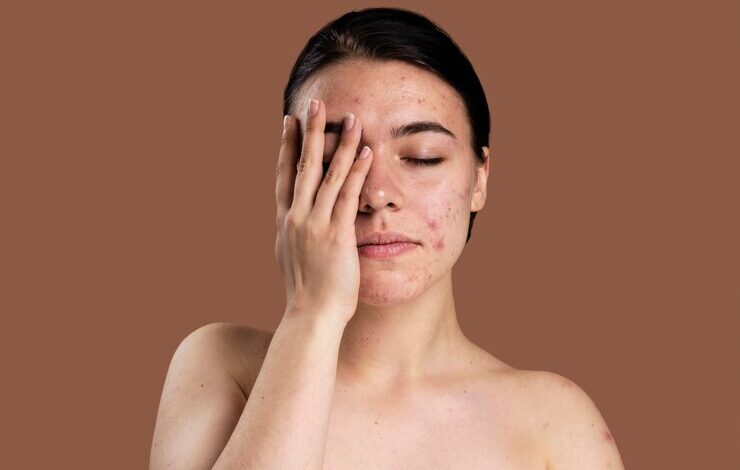
Having healthy skin is essential for overall well-being. It serves as a protective barrier, regulates body temperature, and plays a vital role in our appearance. However, skin disorders and conditions can arise, indicating underlying issues and the need for attention.
In this article, we will explore eight signs of unhealthy skin that you should watch out for. These signs include:
- Acne
- Cold sores
- Blisters
- Hives
- Actinic keratosis
- Rosacea
- Carbuncles
- Latex allergies
These signs can manifest in various ways, such as redness, pain, fluid-filled blisters, itchy welts, thick or scaly patches, facial flushing, and painful lumps under the skin. Recognizing these signs can help identify potential skin problems and guide you in seeking the necessary medical attention.
If you experience widespread rashes, rashes with fever, sudden onset and rapid spreading of a rash, blistering rash, spread of purplish rash, skin discoloration or changes, or bruising or swelling around the rash, it is crucial to consult a doctor for evaluation.
Maintaining healthy skin is essential for your overall health and appearance. By recognizing the signs of unhealthy skin, you can take proactive steps to address any issues and promote skin wellness.
Key Takeaways:
- Acne, cold sores, blisters, hives, actinic keratosis, rosacea, carbuncles, and latex allergies are signs of unhealthy skin to watch out for.
- These signs can manifest as redness, pain, fluid-filled blisters, itchy welts, thick or scaly patches, facial flushing, and painful lumps under the skin.
- Seek medical attention for persistent or worsening skin symptoms.
- Proper skincare, sun protection, and a healthy lifestyle can help maintain skin health.
Acne
In this section, we explore acne, a common skin condition that affects millions of people worldwide. Acne is characterized by various skin abnormalities, including redness, blackheads, whiteheads, pimples, as well as deep, painful cysts and nodules. If left untreated, acne can lead to scarring or darkening of the skin. It is most commonly found on the face, neck, shoulders, chest, and upper back.
Acne is not just a cosmetic concern; it can also be a sign of unhealthy skin and may indicate underlying skin damage. Understanding the signs and symptoms of acne can help individuals take appropriate measures to manage and treat their condition effectively.
| Signs of Acne | Description |
|---|---|
| Redness | Acne-prone skin tends to appear red and inflamed due to increased blood flow to the affected areas. |
| Blackheads | These are small, dark bumps that form when pores become clogged with excess oil and dead skin cells. |
| Whiteheads | Similar to blackheads, these are small, flesh-colored bumps that occur when pores are clogged with oil and dead skin cells. |
| Pimples | Pimples are raised, red bumps on the skin that may contain pus. They can be painful and often appear as a result of bacterial infection. |
| Deep Cysts and Nodules | Deep, painful acne lesions that occur beneath the skin’s surface. These can cause severe discomfort and may leave scars. |
Effective management of acne involves a combination of skincare practices, such as regularly cleansing the skin, using non-comedogenic products, and avoiding excessive scrubbing. In some cases, medical intervention may be necessary, including topical or oral medications prescribed by a dermatologist.
The Psychological Impact of Acne
Living with acne can have a significant emotional and psychological impact on individuals. It can lower self-esteem, cause anxiety, and even lead to depression. Seeking professional support and practicing self-care are essential for maintaining mental well-being while managing acne.
If you are struggling with acne, remember that you are not alone. There are numerous treatment options available, and healthcare professionals can provide guidance and support to help you achieve healthier skin.
Cold Sores
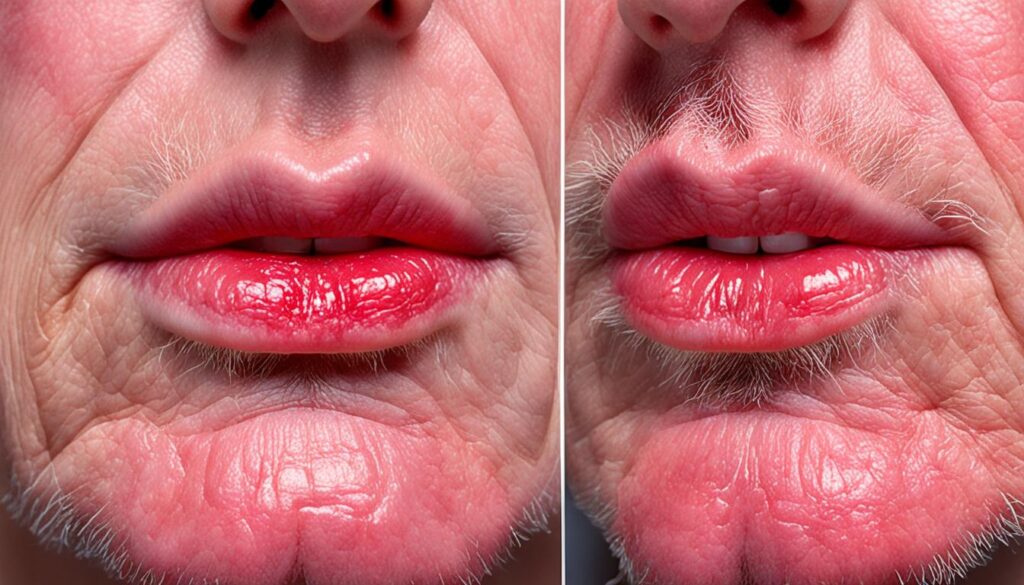
Cold sores are a common skin infection characterized by red, painful, fluid-filled blisters that typically appear near the mouth and lips. These blisters can be accompanied by mild flu-like symptoms and can cause post-inflammatory hyperpigmentation, resulting in dark spots on the skin, particularly in people with darker skin tones.
Cold sores are not only unsightly but also serve as a sign of unhealthy skin. They may indicate an underlying skin infection that requires attention and treatment. It is important to note that cold sores are highly contagious, primarily transmitted through direct contact, and can easily spread to other areas of the body or to other individuals.
To alleviate the discomfort and promote healing, over-the-counter creams or ointments containing antiviral agents, such as docosanol or acyclovir, can be applied topically. In severe cases or when the infection spreads, healthcare professionals may prescribe oral antiviral medications to minimize the duration and severity of the outbreak.
If you are experiencing cold sores, it is important to avoid touching or picking at the blisters, as this can further irritate the skin and delay the healing process. Additionally, practicing good hygiene, such as washing your hands frequently and avoiding close contact with others, can help prevent the spread of cold sores.
Seeking medical advice is recommended if you have frequent or severe cold sore outbreaks, if the blisters do not heal within two weeks, or if they are accompanied by other symptoms such as fever, swollen lymph nodes, or difficulty eating or drinking.
Blisters
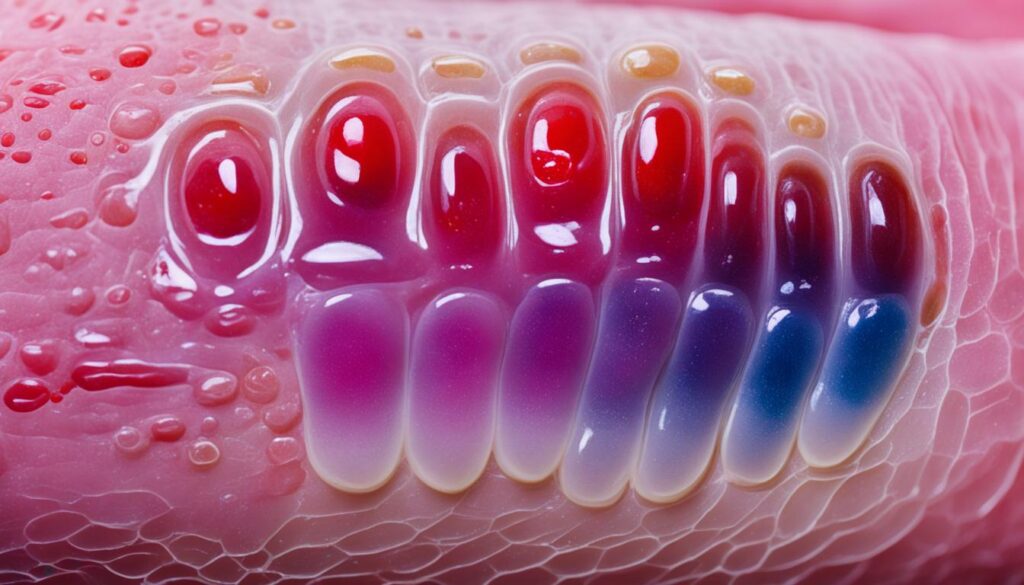
Blisters are a common skin condition that manifests as a watery, clear, fluid-filled area on the skin. They can appear as small blisters called vesicles or larger blisters known as bulla and can occur alone or in groups. Blisters can develop anywhere on the body and are often a visible sign of skin damage or an underlying skin infection.
These fluid-filled blisters can be caused by various factors, such as friction, burns, allergies, infections, or certain skin disorders. They are often accompanied by pain, tenderness, and discomfort.
Blisters serve as a protective response from the body and help shield the underlying skin from further harm or infection. However, excessive blistering or blisters that persist for a prolonged period may indicate an underlying skin condition that requires medical attention.
If you notice recurrent or persistent blisters, it’s crucial to consult a dermatologist or healthcare professional to determine the cause and appropriate treatment. Proper diagnosis and management can help prevent complications and promote healthy skin.
“Blisters can develop anywhere on the body and are often a visible sign of skin damage or an underlying skin infection.”
To effectively manage blisters, it’s important to address the underlying cause and promote healing. Here are some general tips to care for blisters:
- Keep the affected area clean and dry.
- Avoid puncturing or popping the blister to prevent infection.
- If the blister bursts, gently clean the area with mild soap and water, and cover it with a sterile dressing or bandage.
- If needed, your healthcare provider may recommend topical medications or antibiotics to promote healing and prevent infection.
- Wear appropriate footwear or protective gear to minimize friction and pressure on susceptible areas.
- Consider using protective padding or moleskin to cushion the affected area and prevent further irritation.
- Avoid exposing the blister to excessive heat or cold, as extreme temperatures can aggravate the condition.
Remember, if you develop blisters or notice any changes in your skin, particularly if they are accompanied by other concerning symptoms, it’s essential to seek medical advice. Early detection and proper management can help maintain healthy skin and prevent potential complications.
Common Causes of Blisters
| Cause | Description |
|---|---|
| Friction | Repetitive rubbing or pressure on the skin, often seen on the feet and hands |
| Burns | Thermal, chemical, or electrical burns that damage the skin |
| Allergies | Reaction to an irritant or allergen, such as certain medications or contact with specific substances |
| Infections | Bacterial, viral, or fungal infections that affect the skin, including herpes, impetigo, or cellulitis |
| Skin Disorders | Conditions like dermatitis, eczema, or pemphigoid that cause inflammation and blister formation |
Hives
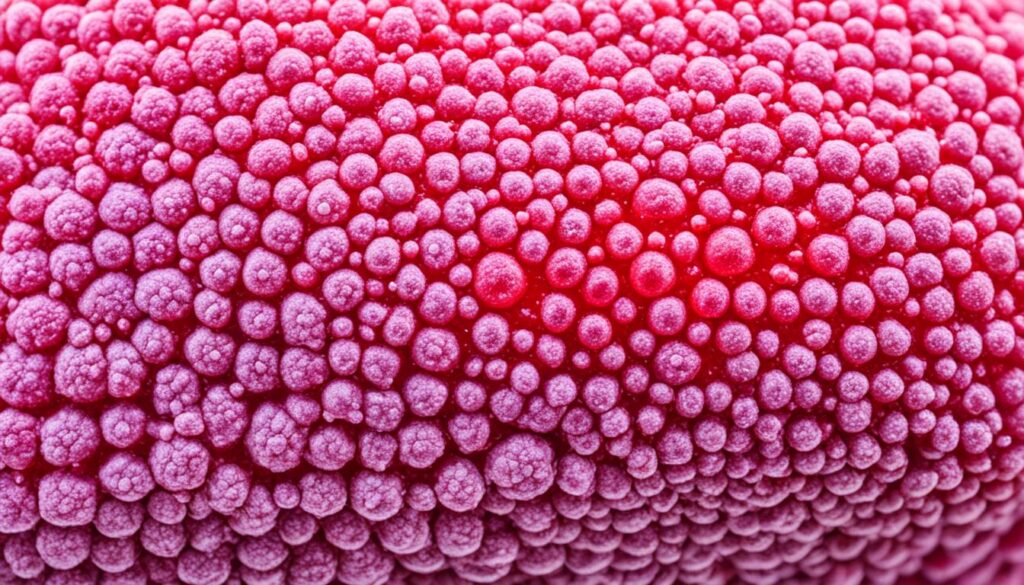
Hives, also known as urticaria, is a skin condition characterized by raised welts that appear after exposure to an allergen. These welts can vary in size and shape, ranging from small, round bumps to larger patches. Hives are typically accompanied by itching, warmth, and mild discomfort.
On darker skin tones, hives may appear raised or inflamed, while on lighter skin, they usually appear as red welts. The sudden appearance of hives can be alarming, and they can be a sign of unhealthy skin.
Common causes of hives include allergic reactions to certain foods, medications, insect bites, or environmental factors such as pollen or pet dander. Stress, temperature changes, and exercise can also trigger hives.
Hives, although often temporary and harmless, can sometimes be a symptom of an underlying medical condition or a more serious allergic reaction. If hives are accompanied by difficulty breathing, facial swelling, or other severe symptoms, immediate medical attention should be sought.
To alleviate the discomfort caused by hives, over-the-counter antihistamines can be used. Applying cool compresses or taking lukewarm baths may also provide relief. However, if hives persist or become more severe, it is important to consult a dermatologist for proper diagnosis and treatment.
Overall, hives are a common skin condition that can occur in individuals of all ages and skin types. While they may not always indicate a serious problem, it is essential to pay attention to any changes in the skin and seek medical advice if needed.
Key Points:
- Hives are raised welts that appear after exposure to an allergen.
- They can be itchy, warm, and mildly painful.
- Hives can vary in size and shape, appearing as small, round bumps or larger patches.
- On darker skin, hives may appear raised or inflamed, while on lighter skin, they typically appear red.
- Hives can be caused by allergic reactions, environmental factors, stress, temperature changes, and exercise.
- Over-the-counter antihistamines and cool compresses can help alleviate hives, but persistent or severe cases should be evaluated by a dermatologist.
Actinic Keratosis

Actinic keratosis is a common skin condition that occurs due to prolonged sun exposure. It is characterized by the presence of rough, scaly, or crusty patches on the skin. These patches are usually found on areas of the body that receive the most sun exposure, such as the hands, arms, face, scalp, and neck. Actinic keratosis patches can vary in color, including shades of pink, brown, tan, or gray.
This skin condition is a clear sign of unhealthy skin and can indicate damage from sun exposure. Actinic keratosis is often considered a precancerous condition and should be taken seriously. If left untreated, it can progress to a type of skin cancer known as squamous cell carcinoma. Therefore, it is important to monitor these patches closely and seek medical attention if any changes or abnormalities are observed.
To prevent actinic keratosis and protect your skin from further damage, it is essential to take certain precautions. These include:
- Using sunscreen with a high SPF regularly
- Wearing protective clothing, such as hats and long sleeves, when exposed to the sun
- Seeking shade during peak sun hours
Early detection and treatment are key in managing actinic keratosis and minimizing the risk of complications. Various treatment options are available, including cryotherapy (freezing), topical medications, laser therapy, and surgical removal.
“Actinic keratosis is a common skin condition caused by sun damage. It appears as rough, scaly patches and can be a precursor to skin cancer. Protecting your skin from the sun’s harmful rays is crucial to prevent actinic keratosis and maintain skin health.”
| Treatment Options for Actinic Keratosis | Pros | Cons |
|---|---|---|
| Cryotherapy | Effective in treating multiple lesions | Possible pain and blistering |
| Topical Medications | Convenient and non-invasive | May cause skin irritation |
| Laser Therapy | Precise treatment targeting | Can be expensive |
| Surgical Removal | Complete removal of affected area | Potential scarring |
Rosacea
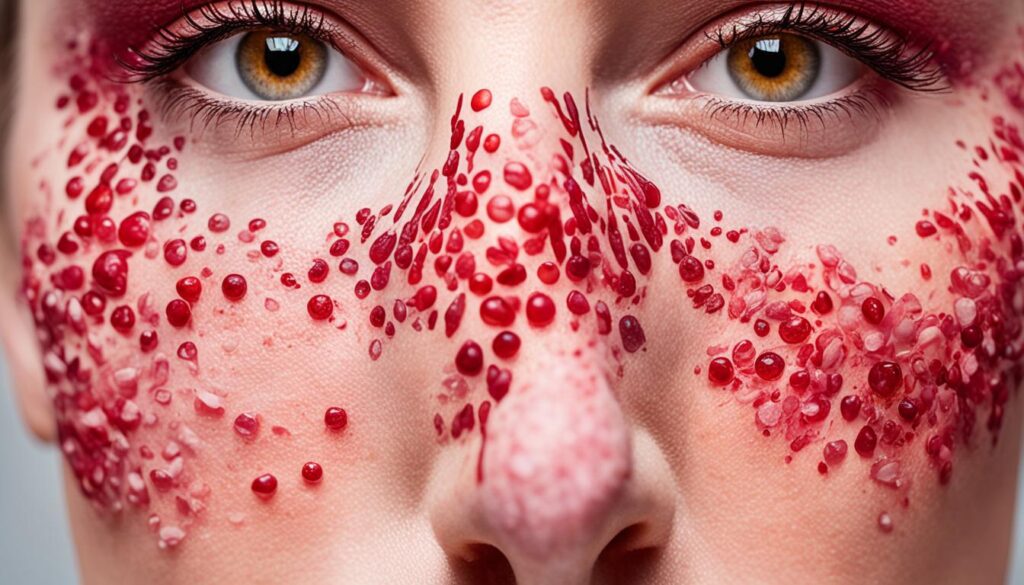
Rosacea is a chronic skin disease that affects millions of people worldwide. It is characterized by facial flushing, raised red bumps, skin dryness, and sensitivity. This condition can cause discomfort and self-consciousness, as it often affects the appearance of the face.
One of the key features of rosacea is its cyclical nature, with periods of flare-ups followed by periods of improvement. Trigger factors such as spicy foods, alcoholic beverages, sunlight, stress, and intestinal bacteria can exacerbate symptoms and lead to flare-ups.
For individuals with darker skin tones, rosacea can also manifest as brown discoloration or dry and swollen patches. It is important to note that rosacea is not just a cosmetic concern, but a sign of unhealthy skin that may indicate underlying skin problems.
While there is no cure for rosacea, there are various treatment options available to manage its symptoms and improve the overall condition of the skin. These may include topical creams, oral medications, laser therapy, and lifestyle modifications.
Understanding the signs of unhealthy skin, such as rosacea, can help individuals seek appropriate medical attention and receive the necessary treatment. It is important to consult with a dermatologist or healthcare professional for a proper diagnosis and personalized treatment plan.
“Living with rosacea can be challenging, both physically and emotionally. However, with the right management strategies and support, individuals can effectively control their symptoms and improve their quality of life.”
Carbuncles
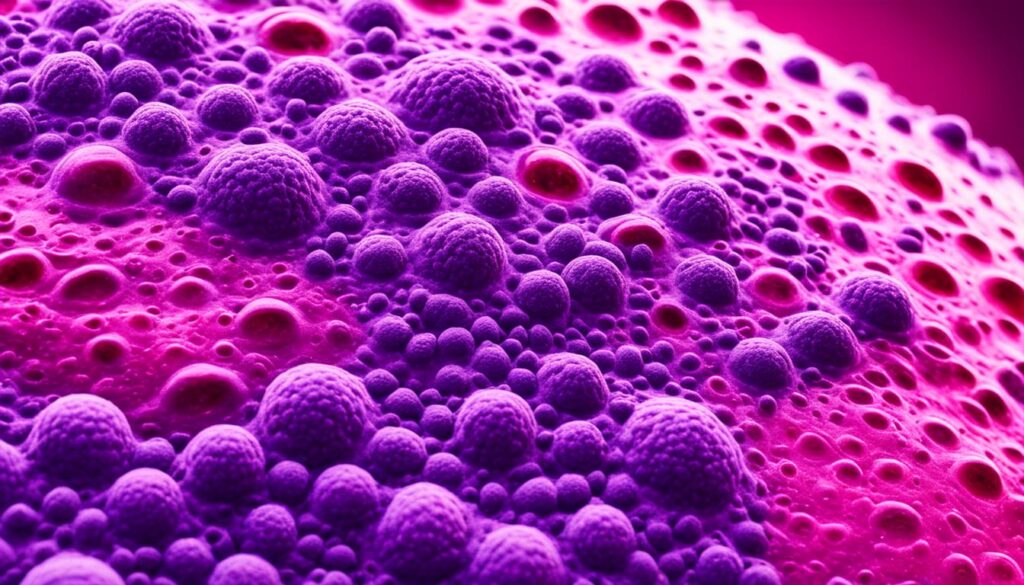
Carbuncles are red, painful, and irritated lumps under the skin. They may be accompanied by fever, body aches, fatigue, and skin crustiness or oozing. Carbuncles may appear more violet on darker skin tones. They are a sign of unhealthy skin and can indicate a skin infection.
| Carbuncles | Cold Sores | Blisters | |
|---|---|---|---|
| Appearance | Red, painful lumps under the skin | Red, painful fluid-filled blisters near the mouth and lips | Watery, clear, fluid-filled area on the skin |
| Accompanying Symptoms | Fever, body aches, fatigue | Mild flu-like symptoms | No specific accompanying symptoms |
| Color Variation on Darker Skin Tones | May appear more violet | May cause post-inflammatory hyperpigmentation (dark spots) | No specific color variation |
| Indicates Unhealthy Skin | Yes | Yes | No |
| Indicates Skin Infection | Yes | Yes | No |
Carbuncles are just one example of how an unhealthy skin condition can manifest. It’s important to pay attention to any signs of skin damage or unhealthy skin, as they can indicate an underlying issue that may require medical attention. Taking proactive steps to care for your skin and seeking professional advice when needed can help maintain healthy and radiant skin.
Conclusion
Maintaining healthy skin is crucial for overall health and well-being. Understanding the signs of unhealthy skin is essential in identifying potential skin problems. From acne, cold sores, blisters, and hives to actinic keratosis, rosacea, and carbuncles, these symptoms can range in severity and indicate underlying skin damage or infections.
When experiencing persistent or worsening skin symptoms, seeking medical attention is vital for accurate diagnosis and appropriate treatment. It is important to establish a proper skincare routine and protect the skin from the sun’s harmful rays. Adopting a healthy lifestyle, including a balanced diet and sufficient hydration, can also contribute to maintaining skin health and preventing potential skincare issues.
By staying vigilant and proactive about skincare warning signs, you can prioritize the well-being of your skin. Take the necessary steps to care for your skin effectively, ensuring its health and vitality in the long run. Remember, healthy skin is not only about looking good but also about feeling good from the inside out.
Also Refer : The Benefits Of Glycerin In Skin Care
FAQs
Q: What are the 8 signs of unhealthy skin?
A: The 8 signs of unhealthy skin include dryness, itchiness, changes in skin color, sensitivity, dehydration, rash, acne, and overall poor skin health.
Q: How does your skin indicate your overall health?
A: Your skin can reveal a lot about your overall health. Signs such as dryness, sensitivity, or unusual changes in skin texture could be indicative of underlying health issues.
Q: What are the common causes of skin problems?
A: Skin problems can be caused by various factors such as hormonal imbalances, dehydration, lifestyle factors, inadequate skin care routine, or even certain medical conditions like inflammatory bowel disease or lupus.
Q: How can lifestyle factors affect your skin health?
A: Lifestyle factors like diet, stress levels, sleep patterns, and skincare habits can significantly impact your skin health. Ensuring a healthy lifestyle can help you maintain healthy skin.
Q: Why is proper skin care important?
A: Proper skin care is crucial as neglecting your skin can lead to various skin problems such as dryness, sensitivity, acne, or premature aging. Following a good skincare routine can help you manage and prevent these issues.
Q: What role does skin hydration play in skin health?
A: Adequate skin hydration is essential for maintaining healthy skin. Dehydrated skin can lead to dryness, itchiness, and other skin problems. Using hydrating skincare products can help improve skin hydration.
Q: How can you determine if your skin needs special attention?
A: Your skin may show signs like increased sensitivity, redness, itchiness, or unusual changes in skin texture, indicating that it needs special care. Consulting a dermatologist can help determine the best course of action.
Q: What are some common signs of poor skin health?
A: Common signs of poor skin health include persistent dryness, acne breakouts, excessive oiliness, inflammation, redness, or flakiness. Addressing these signs can help improve your skin’s condition.





